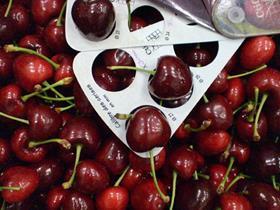
Japanese buyers can expect to receive Northwest cherries with longer shelf life and at lower prices following their government’s agreement to a new phytosanitary protocol on Thursday.
For the 30-plus years that US cherries have been exported to Japan, fumigation by noxious methyl bromide has been a pre-requisite for clearing product into the country as a measure to guard against the spread of pests – notably codling moth and cherry fruit fly.
On Thursday, growers in the Northwest states of Washington and Oregon achieved a major breakthrough when Japan accepted a new protocol based on “a systems approach” to managing the pest concerns as an alternative to fumigation. Under the new protocol, growers are required to place insect traps in their orchards and then fruit must undergo physical inspection at packhouse level.
The new protocol comes as a boon for the industry, since methyl bromide significantly comprises cherry shelf life to the extent that few – if any – cherries from the US have been shipped by ocean freight to date.
“It’s a big deal, not so much because of the volume, but because of the fruit quality,” Jim Archer, manager of Northwest Fruit Exporters, told Seattle Post-Intelligencer. “Fumigation takes a toll on the fruit quality, and it does not have good shelf life.”
Growers in Washington and Oregon reportedly placed traps in their orchards in early to mid-May, according to Mr Archer, meaning that the first meaningful sea shipments should take place this season.
The capacity to ship by sea could not come sooner for exporters, who are in the midst of marketing a record Northwest crop that is expected to reach almost 200,000 tonnes this year. More costly airfreight services make US cherries expensive to Japanese consumers, who have become more price-sensitive in the past few years amid an ailing economy. Furthermore, passenger aircraft have begun to use more stringent cargo screening regulations his year, limiting space and leading to delays.
“Not only will the Japanese consumer see better pricing on our fruit, it will be a better quality product as well,” Jim Archer of the Northwest Fruit Exporters told Fruitnet.com.
Northwest Fruit Exporters is now hopeful that other key markets that also impose fumigation protocols on Northwest cherries – notably Korea and Australia – will follow Japan’s lead.
While the new protocol was approved too late for California cherry growers to take advantage this year, they could participate in future seasons, according to the Seattle Post-Intelligencer.
The precedent for the new protocol was set by New Zealand, which successfully implemented a systems approach protocol for its cherry exports to Japan in 2005.
Japan currently ranks as the fifth largest market for Northwest cherries after Canada, Taiwan, Hong Kong and the UK. Total US cherry exports to Japan, including production from California, reached 9,288 tonnes in 2007, but that figure is almost half the 17,031 tonnes sent in 2001, which was a record year. Exporters will be hoping to hoist shipments back up towards those levels with the aid of the new protocol.



